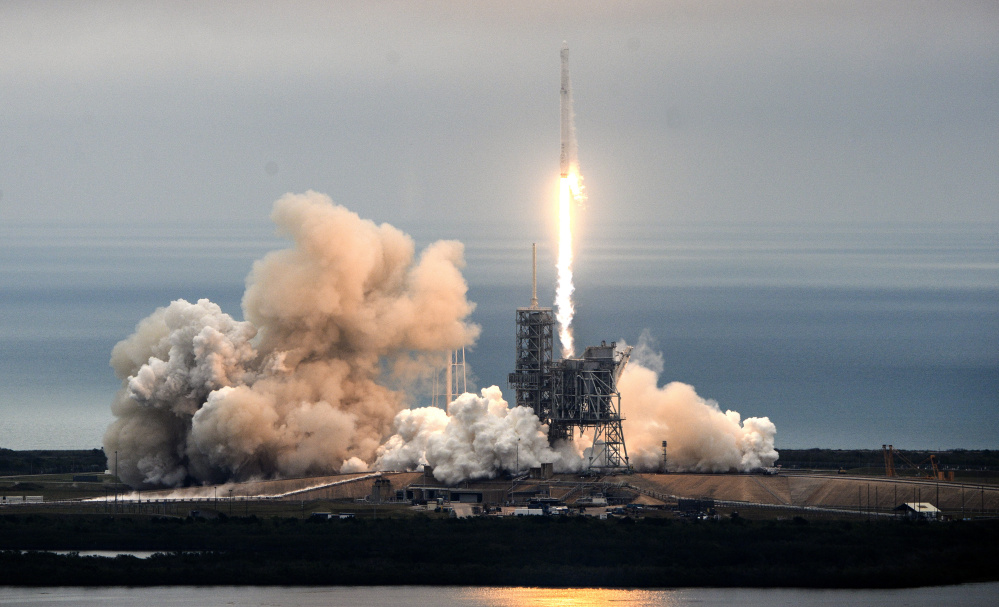CAPE CANAVERAL, Fla. — A SpaceX rocket soared from NASA’s long-idled moonshot pad Sunday, sending up space station supplies from the exact spot where astronauts embarked on the lunar landings nearly a half-century ago.
It was the first flight from NASA’s legendary Launch Complex 39A since the shuttle program ended almost six years ago, and SpaceX’s first liftoff from Florida since a rocket explosion last summer.
The crowds at Kennedy Space Center watched eagerly as the unmanned Falcon 9 rocket took flight with a cargo ship bound for the International Space Station. They got barely 10 seconds of viewing before clouds swallowed up the Falcon as it thundered skyward.
As a special treat, SpaceX landed its leftover booster back at Cape Canaveral eight minutes after liftoff, a feat accomplished only twice before. Most of SpaceX’s eight successful booster landings have used ocean platforms. As they did during the shuttle era, sonic booms heralded Sunday’s return.
SpaceX employees at company flight headquarters in Southern California cheered as the 15-story booster landed upright at its designated parking spot at Cape Canaveral Air Force Station.
SpaceX chief Elon Musk celebrated the successful touchdown via Twitter. “Baby came back,” he tweeted.
The celebratory roar grew when the Dragon cargo ship successfully reached orbit a couple of minutes later. It will reach the space station Wednesday, delivering 5,500 pounds of food, clothes and experiments.
It was SpaceX’s second launch attempt in a row. Saturday’s effort was foiled by last-minute rocket concerns. The repairs paid off, and even the clouds parted enough to ensure a safe flight.
Musk said he’s honored to use Launch Complex 39A. The company hopes to launch astronauts from this spot next year, bringing U.S. crew launches back to home soil after a longer-than-intended hiatus. SpaceX Mars missions, first robots and then people, could follow from here.
If the pad weathered Sunday’s launch well, another Falcon could be standing there for a satellite send-up in just two weeks.
Kennedy Space Center’s director Robert Cabana, a former shuttle commander who flew four times from 39A, is thrilled to see the pad used for commercial flights like this “instead of just sitting out there and rusting away.” It’s a stark contrast, he noted, to the depression that followed the final shuttle mission in 2011.
It was a momentous comeback for SpaceX. The last time SpaceX had a rocket ready to fly from Cape Canaveral, it blew up on a neighboring pad during prelaunch testing on Sept. 1. Although the company successfully returned to flight last month from California, the focus was on getting leased Launch Complex 39A ready for action given that the pad with the accident was left unusable. The damaged pad should be back in action later this year.
Built in the mid-1960s for the massive Saturn V moon rockets, Launch Complex 39A has now seen 95 launches. Apollo 11’s Neil Armstrong, Buzz Aldrin and Michael Collins left Earth from here on July 16, 1969, on the first moon-landing mission. The first space shuttle pilots, John Young and Robert Crippen, soared from here on April 12, 1981.
Send questions/comments to the editors.



Success. Please wait for the page to reload. If the page does not reload within 5 seconds, please refresh the page.
Enter your email and password to access comments.
Hi, to comment on stories you must . This profile is in addition to your subscription and website login.
Already have a commenting profile? .
Invalid username/password.
Please check your email to confirm and complete your registration.
Only subscribers are eligible to post comments. Please subscribe or login first for digital access. Here’s why.
Use the form below to reset your password. When you've submitted your account email, we will send an email with a reset code.